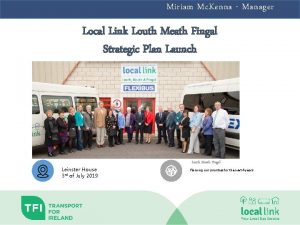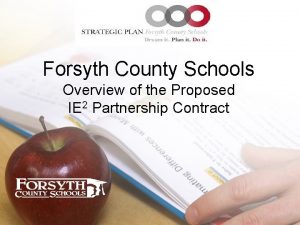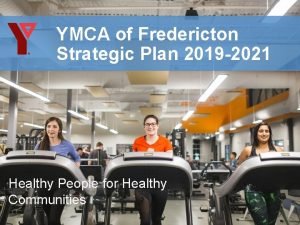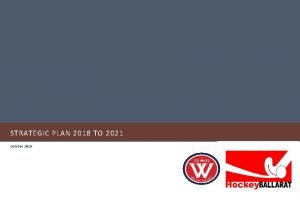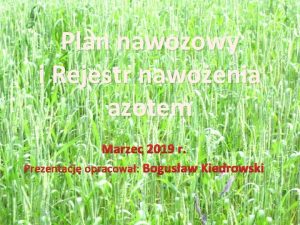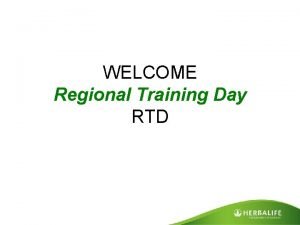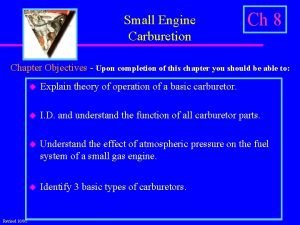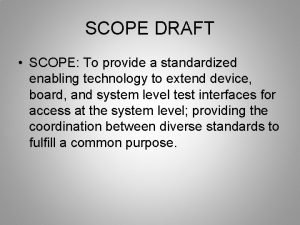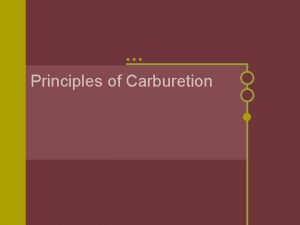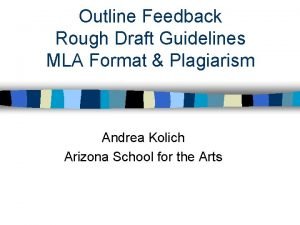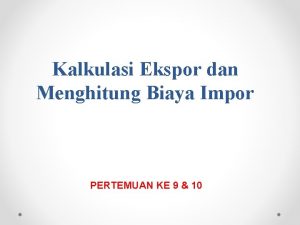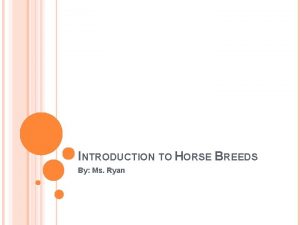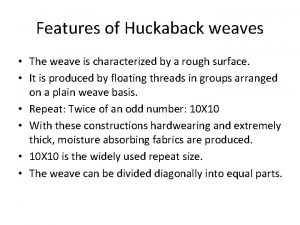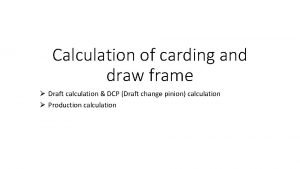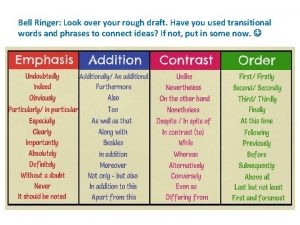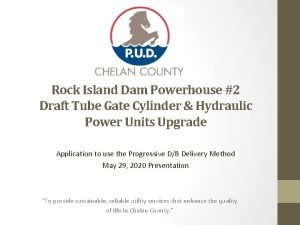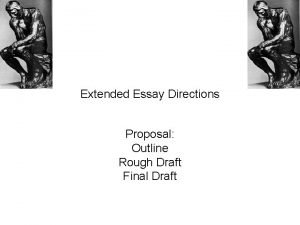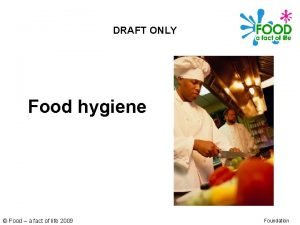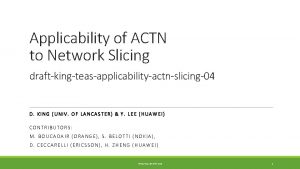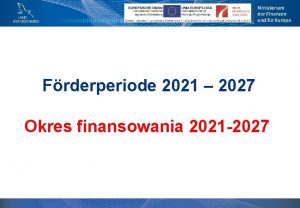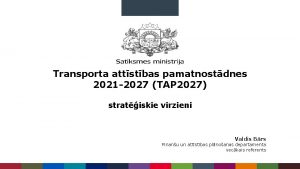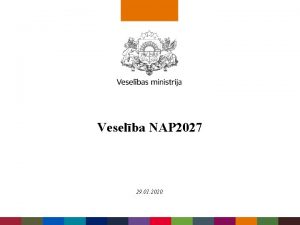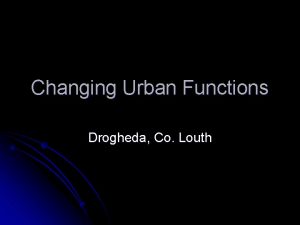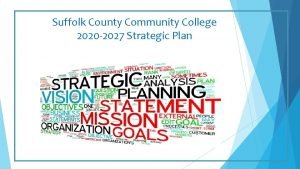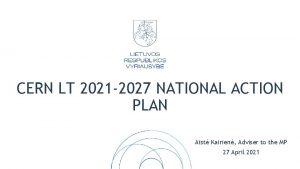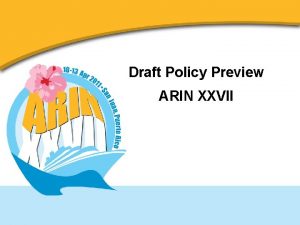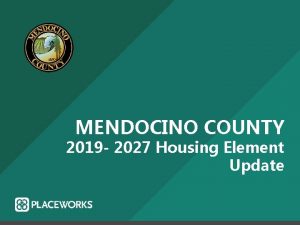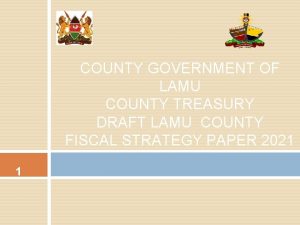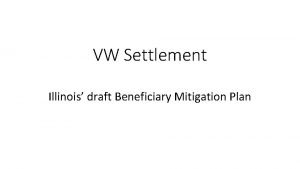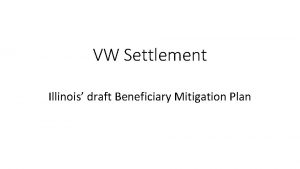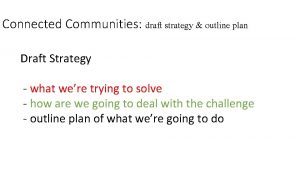Louth County Development Draft Plan 2021 2027 Overview

























































- Slides: 57

Louth County Development Draft Plan 2021 -2027 Overview of the Draft County Development Plan 2021 -2027

Introduction • Presentation will provide an overview of the content of the Draft County Development Plan. • The layout/structure of the Draft Plan will be set out. • Any updates/changes to policy will be highlighted. • It is hoped that the presentation will assist members of the public in answering any queries. • Forward Planning Team are available be email, phone, or online meetings to discuss any queries.

Purpose of Plan Provides policy objectives that will guide development over the next 6 years in the County. Need to ensure: • Strong Plan that provides certainty to support sustainable economic development. • Key decisions are made at plan stage and not left to the development management process. • Evidence based planning and consistency with national and regional policy. • Policies and zoning objectives consistent with proper planning and sustainable development.

Stages in preparing the Louth County Development Plan 2021 -2027 Stage 1 - Weeks 1 -48 • Public Consultation – Issues Paper • Chief Executive report on Consultation • Direction from Elected Members • Preparation of Draft Development Plan Stage 1 - Pre Draft Consultation Stage 2 - Weeks 48 -85 Stage 2 - Draft Development Plan • Public Consultation – Draft Plan • Chief Executive Report on Submissions • Consideration of Chief Executive Report by Elected Members Stage 3 - Weeks 85 -104 • Public Consultation – Amendments • Chief Executive Report on Submissions • Considerations of Chief Executive Report by Elected Members Stage 3 – Amendments to Draft Plan Adoption of Louth County Development Plan 2021 -2027

Updated National and Regional Policy • New National and Regional planning policy is set out in the NPF and RSES; departure from the ‘Business as Usual’ approach. • Louth now in the Eastern and Midland Region. • Drogheda & Dundalk: § § § Designated Regional Growth Centres in RSES Target population of 50, 000 by 2031 Develop as cities of scale Drivers of national and regional economic growth Significance in Dublin-Belfast Economic Corridor

Integrating Drogheda, Dundalk, and Ardee into the County Development Plan • The abolition of the Town Councils as part of the Local Government Reform Act means that the former Town Council Areas of Drogheda, Dundalk, and Ardee are now also included in the County Development Plan process. • The Draft County Development Plan covers the entire County area. • Land Use Zoning Maps have been published for all settlements, including the higher tier settlements of Drogheda, Dundalk, Ardee, and Dunleer. • Following the adoption of the County Development Plan Local Area Plans/Urban Area Plans will be prepared for Drogheda, Dundalk, Ardee, and Dunleer.

Breakdown of the Draft County Development Plan 2021 -2027 There are 5 Volumes in the Draft County Development Plan as follows: Volume Title Volume 1 Written Statement Volume 1 A Books of Maps for the RGCs, Self Sustaining Growth Towns, and Rural Policy Zones Volume 2 Towns and Village Statements Volume 3 Appendices Volume 4 Record of Protected Structures Volume 5 Environmental Reports – Strategic Environmental Assessment, Appropriate Assessment, and Strategic Flood Risk Assessment

Volume 1 – Written Statement Chapter Title Chapter 1 Introduction Chapter 2 Core Strategy and Settlement Strategy Chapter 3 Housing Chapter 4 Community Facilities Chapter 5 Economy and Employment Chapter 6 Tourism Chapter 7 Movement Chapter 8 Natural Heritage, Green Infrastructure and Biodiversity Chapter 9 Built Heritage and Culture Chapter 10 Infrastructure and Public Utilities Chapter 11 Environment, Natural Resources and the Coast Chapter 12 Climate Action Chapter 13 Development Management Guidelines Chapter 14 Implementation and Monitoring

Volume 1 – Written Statement – Changes in structure from the current Plan • Throughout the Draft Plan there are references and associated policy objectives relating to Drogheda, Dundalk, Ardee, and Dunleer – this will provide the foundation for the Local/Urban Area Plans. • New Chapters: § Chapter 6 – Tourism § Chapter 12 – Climate Action § Chapter 13 – Development Management Guidelines • Other key changes: § Rural Housing Policy is now set out in Chapter 3 Housing § Built and Natural Heritage Chapter has been sub-divided into 2 chapters: • Chapter 8 - Natural Heritage, Green Infrastructure and Biodiversity • Chapter 9 - Built Heritage and Culture

Chapter 1 – Introduction • Sets the scene for the Draft County Development Plan. • The importance of Drogheda and Dundalk in the future growth and development of the County is highlighted. • The Vision for the Draft County Development Plan and the Strategic Policy Objectives are set out.

Chapter 2 – Core Strategy and Settlement Strategy • The purpose of the Core Strategy is to set out an evidence based strategy for the future development of the County. • Required to demonstrate the Plan is aligned and consistent with National and Regional policy i. e. NPF and RSES. • Key elements of the Core Strategy: • A Settlement Hierarchy • Population and Housing Projections • Quantum of land required to facilitate growth

Settlement Hierarchy • Settlement categories and typologies updated in the NPF and RSES. • NPF identified the role of Drogheda and Dundalk as regional centres that will function as key drivers in the growth and development of the Region. • 3 Regional Growth Centres in the Eastern and Midland Region – Drogheda, Dundalk, and Athlone.

Settlement Hierarchy • Settlement Hierarchy is set out in Table 2. 4 of the Draft Plan. • 5 Levels of Settlements identified as follows: • Level 1 – Regional Growth Centres • Level 2 – Self-Sustaining Growth Towns • Level 3 – Self-Sustaining Towns • Level 4 – Small Towns and Villages • Level 5 – Rural Villages

Settlement Hierarchy Settlement Level Settlement Category Description Settlement Regional Growth Centres are large towns with a high level of self-sustaining employment and services that act as regional economic drivers and play a significant role for a wide catchment area. Drogheda Dundalk Self-Sustaining Growth Towns with a moderate level of jobs and services – includes sub-county market towns and commuter towns with good transport links and capacity for continued commensurate growth to become more self-sustaining. Ardee Dunleer 3 Self-Sustaining Towns Self-sustaining towns with high levels of population growth and a weak employment base which are reliant on other areas for employment and/or services and which require targeted ‘catch up’ investment to become more self-sustaining. Carlingford, Clogherhead, Castlebellingham/Kilsaran, Termonfeckin, Tullyallen 4 Small Towns and Villages Towns and villages with local service and employment functions. Annagassan, Baltray, Collon, Dromiskin, Knockbridge, Louth Village, Omeath, Tallanstown, Rural villages. Ballagan, Ballapousta, Bellurgan, Darver, Dromin, Faughart, Glenmore, Grangebellew, Greenore, Gyles Quay, Kilcurry, Kilkerley, Lordship, Mountbagnal, Muchgrange, Philipstown (Collon), Ravensdale, Reaghstown, Sandpit, Sheelagh, Stabannon, Tinure, Willville 1 2 5 Rural Villages

Settlement Hierarchy Settlement Level Settlement Category 1 Regional Growth Centres 2 Self-Sustaining Towns 3 Growth Self-Sustaining Towns Description Regional Growth Centres are large towns with a high level of self-sustaining employment and services that act as regional economic drivers and play a significant role for a wide catchment area. Self-Sustaining Growth Towns with a moderate level of jobs and services – includes sub-county market towns and commuter towns with good transport links and capacity for continued commensurate growth to become more self-sustaining. Self-sustaining towns with high levels of population growth and a weak employment base which are reliant on other areas for employment and/or services and which require targeted ‘catch up’ investment to become more self-sustaining. 4 Small Towns and Villages Towns and villages with local service and employment functions. 5 Rural Villages Rural villages. Settlement Drogheda Dundalk Ardee Dunleer Carlingford, Clogherhead, Castlebellingham/Kilsaran, Termonfeckin, Tullyallen Annagassan, Baltray, Collon, Dromiskin, Knockbridge, Louth Village, Omeath, Tallanstown, Ballagan, Ballapousta, Bellurgan, Darver, Dromin, Faughart, Glenmore, Grangebellew, Greenore, Gyles Quay, Kilcurry, Kilkerley, Lordship, Mountbagnal, Muchgrange, Philipstown (Collon), Ravensdale, Reaghstown, Sandpit, Sheelagh, Stabannon, Tinure, Willville

Projecting future population growth • NPF Implementation Roadmap provided each Local Authority with a projected population for 2026 and 2031. County 2016 2026 Louth 129, 000 139, 000 144, 500 2026 incl. 25% Headroom 141, 500 148, 375 Population Projected to Increase 2027 2016 -2027 2031 149, 966 144, 000 151, 500 21, 082 County Population Increase 20062016 Average Annual Increase 20062016 Projected Population Increase 20162027 Louth 17, 617 1, 762 21, 082 Projected Annual Average Population Increase 20162027 1, 916

Projected population growth at County level 2016 -2027 Population 2016 Projected population 2027 Total projected population increase Projected annual average increase 2016 -2027 Annual average population increase 2006 -2016 128, 884 149, 966 21, 082 1, 916 1, 762

Housing Projections – occupancy rate Population 2016 Total Housing Vacant Stock 2016 128, 884 51, 399 Units Vacancy 2016 3, 952 Rate 7. 7% Average Occupancy Rate 2016 2. 76 Projected Population 2027 Projected Average Household Occupancy Rate Projected Occupied Vacancy Households Rate 2027 Projected Housing Stock 2027 Projected Additional Housing Required 2016 -2027 149, 966 2. 6 57, 679 61, 717 10, 318 7% Projected Housing Requirement 2016 -2027 Approximate number of units completed 2016 -2020 Projected Housing requirement 2021 -2027 10, 318 2, 040 8, 278

Population and Housing projections at a County level Projected Settlement Population Category 2016 Increase to 2027 Total Additional Projected Housing Units Stock 2027 2016 -2027 Approx. Housing Units Allocation Completed 2021 -2027 2016 -2020 County 61, 717 2, 040 Louth 128, 884 21, 082 149, 966 10, 318 8, 278

Growth Strategy • Informed by national and regional policy. • Securing compact and sustainable growth an important element. • Supporting urban regeneration and the redevelopment of vacant and under-utilised lands. • Focus of growth will be in the Regional Growth Centres. • The potential of Ardee and Dunleer to facilitate growth also recognised. • In the self-sustaining towns the emphasis will be on employment generation balanced with residential growth. • In the smaller settlements the focus will be on localised growth. • Addressing rural decline by supporting the sustainable growth and regeneration of rural towns and villages.

Growth Strategy – Residential land requirement • The quantum of residential lands identified has to be aligned with the housing allocation in each settlement. • A Land Use Evaluation and Infrastructure Assessment was carried out for each settlement – see appendix 2 of Volume 3. • The Plan acknowledges that there are large areas of zoned lands dependent on the delivery of infrastructure which will be built out on a phased basis. • Currently there is an excess of residential lands in the County. • Any excess lands have been placed in a ‘Strategic Reserve’ and will not be available for development until after 2027. • A Zoning Map has been prepared for each settlement and is included in Volume 1 A and Volume 2.

Chapter 3 – Housing • Sets out a vision and strategy for housing in urban and rural areas. • Strategy is aligned with National and Regional Policy: • Promoting compact growth and the redevelopment of infill and brownfield sites in the built up areas of settlements. • Support the redevelopment of rural towns and villages. • A Housing Strategy is included in Volume 3 - evaluates the housing needs of the existing and future population.

Key objectives of the Chapter • Ensuring there will be sufficient lands available to meet the housing needs of the County in line with projected population growth. • Need to take account of the ‘pent up demand’ for housing. • Promoting urban regeneration and infill development. Support for any URDF funded projects. • Promoting higher densities and building heights particularly in central locations in Drogheda and Dundalk.

Key objectives of the Chapter • Emphasis placed on a sequential approach to development – build from the centre out. • Promote more sustainable modes of transport in the design and location of new developments. • Policy objectives include dwelling mix, adaptable housing, housing for older people, specialist housing, and traveller accommodation. • Policy framed on national and regional policy and section 28 guidelines.

Housing in the Open Countryside • Rural Housing Policy is located in section 3. 17 of Chapter 3. • Guidance on siting and design set out in section 13. 9. 38 of Chapter 13. • Underlying objective of the policy is to find a balance that can facilitate growth and support for rural communities whilst also protecting the countryside.

Development Pressure Areas • Developed based on the methodology set out in the NPF. • POWSCAR data from Census 2016 used to identify rural areas within the commuter catchment of Drogheda, Dundalk, and the Dublin Metropolitan Area.

Rural Development Pressure Map

Rural Policy Zones • Recognised that in addition to areas being within the commuter catchment there also parts of the County that warrant additional protection due to their landscape and cultural value. • 6 Development Control Zones in the current Plan – these have been consolidated into 2 Rural Policy Zones.

Rural Policy Zones Current County Development Plan Draft County Development Plan

Rural Policy Zones Policy Zone Rural Policy Zone 1 Rural Policy Zone 2 Description Area under strong urban influence and of significant landscape value Area under strong urban influence

Rural Policy Zone 1 • Consists of the following areas of landscape and cultural value: Areas of Outstanding Natural Beauty Carlingford and Feede Mountains Clogherhead and Port Oriel Areas of High Scenic Quality Feede Mountains and Cooley Area Monasterboice Boyne Valley/King Williams Glen Collon Uplands Dunany Ardee Bog Areas of Cultural Value Bru na Boinne World Heritage Site Tentative World Heritage Site of Monasterboice Battle of the Boyne Battlefield Site

Qualifying Criteria • Rural Policy Zone 1: § Significant involvement in agriculture. § Children of qualifying landowners: • Landholding must be a minimum of 3 hectares and owned for a minimum of 10 years. • 2 additional dwellings in addition to the family home will be allowed subject to appropriate siting, design etc. Applicants shall not have previously owned a dwelling.

Qualifying Criteria • Rural Policy Zone 2 • Significant involvement in agriculture. • Business requires residence in rural area. • Landowners and their children (must have resided in the area for 18 years). • Native residents – lived in the area for 18 years. • Returning emigrants (must have resided in the area for 18 years). • Native residents caring for elderly persons. • Persons required to live in rural area for exceptional health reasons. • Persons who have been native residents for at least 10 years and have lost their home due to separation, divorce, or repossession.

Some Key Changes Criteria Current Plan Draft Plan Duration of residence to be considered a native resident of the rural area 10 years 18 years Home Ownership Must not have owned a house for a minimum of 5 years in the rural area of the County Must not have owned a house for a minimum of 10 years anywhere in the County

Siting and Design § Section 13. 9. 38 of Chapter 13 sets out the criteria to be considered in the preparation/assessment of an application for a rural dwelling. § A key consideration will be the existing patterns of development in the area. This includes: • The existing pattern of development • General character of the area – is this being eroded? • Infrastructure – can the local road network accommodate further development? § Planning permission may be refused if it is apparent the area is becoming overdeveloped.

Siting and Design § Design – should be sensitive to the landscape in which the dwelling would be located – any prominent or obtrusive dwellings unlikely to be granted permission. § Design – specific criteria for development within Brú na Bóinne, the Tentative World Heritage Site of Monasterboice, and the Battle of the Boyne Battlefield Sites. § No maximum floorspace on the gross floorspace of dwellings – will be assessed on a case by case basis. § Access – Minimum visibility standards set out in Table 13. 13 – Plan indicates that higher standards may be required depending on the characteristics of the road and traffic volumes and speeds. § Protected National and Regional Routes – set out on Map 3. 2 and Tables 7. 5 and 7. 6.

Rejuvenation of Small Towns and Villages § The role of towns and villages in supporting vibrant and sustainable communities is recognised. § Applicants proposing to build in a Level 5 settlement will be required to demonstrate a rural housing need in accordance with the criteria set out in Table 3. 5 of the Draft Plan.

Chapter 4 – Social and Community • Creating strong and healthy communities. • Guidance regarding location of education, healthcare and childcare facilities. • Importance of community facilities to build social infrastructure and inclusivity.

Chapter 5 - Economy and Employment • It is an objective of the Draft Plan to strengthen the economic base of the County, attract investment, and support job creation. • Challenges facing economic growth such as dealing with the fallout of Covid-19 and the potential implications of Brexit are highlighted. • Economic Strategy is closely aligned to national and regional economic policy and the Economic Goals of the LECP. • Locational advantage of Louth along the Dublin-Belfast Economic Corridor emphasised.

Chapter 5 - Economy and Employment • The importance of connectivity and infrastructure investment in maintaining economic competitiveness is highlighted. • Future economic investment to be concentrated in the Regional Growth Centres of Drogheda and Dundalk. • Opportunities for economic investment and development in the Self. Sustaining Growth Towns of Ardee and Dunleer. • In the Self-Sustaining Towns, Small Towns, and Villages there will be opportunities for locally based employment generating development reflective of the size of the settlement.

Chapter 5 - Economy and Employment • The contribution of the Rural Economy in providing local employment is acknowledged with support given to rural enterprises of an appropriate scale and location. • The opportunities for Co-Working facilities and Home-Based Economic Activities is acknowledged. • Chapter 13 provides specific guidance for Employment Related Developments in Urban and Rural locations.

Chapter 6 - Tourism • In recognition of the role of tourism within the County and the potential for growth within the sector, the Draft Plan includes a dedicated Tourism chapter for the first time. • The overall aim is to support sustainable tourism development in Louth and strengthen the contribution that tourism makes to the local communities, culture and economy of the County. • The Draft Plan seeks to continue to develop the role of tourism and the development of a high quality and diverse tourism product throughout the County in a balanced and sustainable manner.

Chapter 7 - Movement • Incorporates all policy objectives pertaining to any mode of transportation i. e. walking, cycling, roads and rail. • A functional and sustainable transport network is important in creating an environment where businesses can thrive and people can enjoy a balanced and healthy lifestyle. • Strategic location of Louth along the Dublin-Belfast Economic Corridor with excellent road and rail links emphasised. • Support given to the continued integration of land use and transport planning which will facilitate greater uptake of more sustainable modes of transport including walking, cycling, public transport and electric/low emission vehicles.

Chapter 7 - Movement • Public Transport – support given to continued investment in bus and rail services in the County and associated infrastructure including park and ride facilities. • Walking and Cycling – support given to projects such as public realm or environmental improvement schemes that would improve connectivity, permeability and walking and cycling infrastructure in settlements. • Greenways – support for the continued investment in the network of Greenways e. g. Great Eastern Greenway, Louth Coastal Way – linked with coastal defence projects, Dundalk to Sligo Greenway, Boyne Greenway

Chapter 7 - Movement • Key Road and Rail Projects to be progressed include: § § § DART Expansion to Drogheda N 2 Ardee to Castleblaney N 52 Ardee Bypass Drogheda Port Access Northern Cross Route (PANCR) Dundalk Link Roads • Chapter 13 provides specific criteria for transport related development including car parking and cycling standards, Work Place Travel Plans, and Traffic and Transport Assessments.

Chapter 8 – Natural Heritage, Biodiversity and Green Infrastructure • Identifies the importance of natural heritage, biodiversity, and green infrastructure to the social and economic development of the County. • Policy objectives in this Chapter relate to the conservation and protection of environment including: SACs, SPA’s , p. NHA’s, AONB’s , AHSQ, trees, views and scenic routes.

Chapter 9 - Built Heritage and Culture • Built Heritage § Surrounds us and helps define us and contributes to the development of a strong sense of place. • Archaeological Heritage § Consists of surviving material remains left behind from past societies. § Encompasses: • National Monuments, historic monuments, zones of archaeological potential, walled towns, battlefield sites, UNESCO World Heritage site, tentative World Heritage sites, Architectural heritage, ACAs, Historic Gardens and designed landscapes, Vernacular heritage • Record of Protected Structures – Volume 4 § Two proposed additions in the Draft Plan

Chapter 9 – Built Heritage and Culture – Proposed Amendments to RPS Blackmill Bridge Ardee Bridge

Chapter 10 – Infrastructure and Public Utilities Issues addressed in this Chapter include: • Water, Wastewater, Surface Water • Flood Risk Management • Communications § Broadband § Telecommunications • Energy § Renewable § Non-Renewable

Chapter 11 – Environment, Natural Resources, and the Coast • Cross cutting themes: § Policies on Climate Action, Noise emissions, Light Pollution, Air Quality, Radon, Soil, Water Quality, Nitrate Vulnerable Zones, Waste Management, Veterinary Services. § Natural Resources: • Forestry, Extractive Industry, The Coast, Ports and Harbours, Coastal tourism and recreation, Shellfish Waters – two designated areas in Co. Louth – Carlingford Lough and Dundalk Bay, Aquaculture – 7 production units within County Louth, mussel and oyster aquaculture activity.

Chapter 12 - Climate Action • Climate Change is acknowledged as being one of the most important and urgent issues at an international, national and local level. • The overall aim is to promote, support and direct effective climate action policies and objectives that seek to improve climate outcomes across the settlement areas and communities of County Louth helping to successfully contribute and deliver on the obligations of the State to transition to a low carbon and climate resilient society through the encouragement and integration of appropriate mitigation and adaptation considerations and measures into all development.

Chapter 12 - Climate Action • Although it is a standalone chapter, Climate Action is a fundamental cross cutting theme which runs throughout each of the other chapters of the Draft Plan. • The Climate Action chapter outlines the approach to climate adaptation and mitigation which has been taken within the Draft Plan. • Climate Action mitigation and adaptation strategies have been integrated throughout the Draft Plan and each chapter of the Draft Plan contains policy objectives which contribute to achieving low carbon and climate resilient development within the County.

Chapter 12 - Climate Action • The Climate Action chapter outlines 7 policy objectives which provide overarching support for theme of Climate Action within the Draft Plan. • The chapter outlines the approach to Climate Change adaptation within County Louth within key areas; § § § Integrated Land Use Planning Green Infrastructure Flood Risk Management Urban and Rural Regeneration Renewable Energy

Chapter 13 – Development Management Guidelines • The chapter sets out the standards and guidelines to be applied in the assessment of development proposals. • The Land Use Zoning Categories and associated Zoning Objectives and uses that are ‘Generally Permitted’ and ‘Open for Consideration’ are set out. • The Land Use Zoning Categories have been updated to provide a standardised Land Use Zoning across the County.

Have your Say! How: Ø Written: Forward Planning Unit, Development Plan Review, Louth County Council, Town Hall, Crowe Street, Dundalk, Co Louth, A 91 W 20. Or Ø Email: louthcdp@louthcoco. ie All submissions/ observations should: be entitled Draft Louth County Development Plan 2021 -2027 and include your name and address on a separate sheet (assist with data protection as to be published online).

Have your Say! Closing date is Wednesday 23 rd December 12 noon (late submissions not accepted). Any queries on the Draft Plan can be emailed to devplanqueries@louthcoco. ie

Contact 1890 202 303 info@louthcoco. ie County Hall Millennium Centre St Alphonsus Road Dundalk A 91 KFW 6 Townhall Crowe Street Dundalk County Louth A 91 W 20 C Civic Centre Fair Street Drogheda County Louth A 92 P 440 Follow us @louthcoco Mid Louth Civic Services Centre Fair Green Ardee County Louth A 92 RYT 2
 Politica de coeziune 2021-2027
Politica de coeziune 2021-2027 Fonds structurels européens 2021-2027
Fonds structurels européens 2021-2027 Arhitectura programelor operationale
Arhitectura programelor operationale Connecting europe facility 2021-2027
Connecting europe facility 2021-2027 Big data test infrastructure
Big data test infrastructure Heel and toe arrangement in carding
Heel and toe arrangement in carding Flexibus fingal
Flexibus fingal Jeune espagnol 2027
Jeune espagnol 2027 Jeune espagnol 2027
Jeune espagnol 2027 Nap 2027
Nap 2027 Forsyth county schools overview
Forsyth county schools overview Vietnam socio-economic development strategy for 2021-30
Vietnam socio-economic development strategy for 2021-30 Conference point shaklee
Conference point shaklee Primerica compensation plan 2021
Primerica compensation plan 2021 Ymca strategic plan 2021
Ymca strategic plan 2021 Strategic plan 2018 to 2021
Strategic plan 2018 to 2021 Plan nawozowy jak obliczyć
Plan nawozowy jak obliczyć Plan remedial clasa 4
Plan remedial clasa 4 Work immersion site
Work immersion site Herbalife
Herbalife Rough drafts examples
Rough drafts examples Rough draft organizer
Rough draft organizer Types of carburetors
Types of carburetors Sports rough draft
Sports rough draft 1971 draft lottery chart
1971 draft lottery chart Mrl draft
Mrl draft Natural draft carburetor
Natural draft carburetor Draft scope
Draft scope Component of research proposal
Component of research proposal Credibility gap
Credibility gap Natural draft carburetor
Natural draft carburetor Mla rough draft format example
Mla rough draft format example Kpi templates
Kpi templates Contoh perhitungan
Contoh perhitungan Draft horse organism classifications
Draft horse organism classifications Rough draft format
Rough draft format Tech draft
Tech draft Mock leno weave characteristics
Mock leno weave characteristics Wesel inkaso (collection draft)
Wesel inkaso (collection draft) Research title proposal example
Research title proposal example Portfolio content
Portfolio content Draft in carding machine
Draft in carding machine How to start a counterclaim
How to start a counterclaim Nfl marketing strategy
Nfl marketing strategy Exposure draft adalah
Exposure draft adalah Draft tube gate
Draft tube gate Beef me up
Beef me up John louis von neumann
John louis von neumann Manage draft beer
Manage draft beer Draft token request
Draft token request A rough draft english subtitles
A rough draft english subtitles Vertical integration
Vertical integration Drawing lines and symbols
Drawing lines and symbols Food facts draft
Food facts draft Meloxicam famotidina ciclobenzaprina
Meloxicam famotidina ciclobenzaprina Tear off slip letter
Tear off slip letter Reviewing and correcting the final draft of a message is
Reviewing and correcting the final draft of a message is Network slicing draft
Network slicing draft






